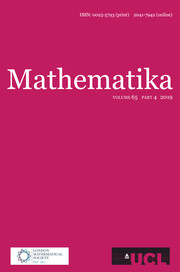Article contents
SUR LES PLUS GRANDS FACTEURS PREMIERS D’ENTIERS CONSÉCUTIFS
Published online by Cambridge University Press: 05 April 2018
Abstract
Let  $P^{+}(n)$ denote the largest prime factor of the integer
$P^{+}(n)$ denote the largest prime factor of the integer  $n$ and
$n$ and  $P_{y}^{+}(n)$ denote the largest prime factor
$P_{y}^{+}(n)$ denote the largest prime factor  $p$ of
$p$ of  $n$ which satisfies
$n$ which satisfies  $p\leqslant y$. In this paper, first we show that the triple consecutive integers with the two patterns
$p\leqslant y$. In this paper, first we show that the triple consecutive integers with the two patterns  $P^{+}(n-1)>P^{+}(n)<P^{+}(n+1)$ and
$P^{+}(n-1)>P^{+}(n)<P^{+}(n+1)$ and  $P^{+}(n-1)<P^{+}(n)>P^{+}(n+1)$ have a positive proportion respectively. More generally, with the same methods we can prove that for any
$P^{+}(n-1)<P^{+}(n)>P^{+}(n+1)$ have a positive proportion respectively. More generally, with the same methods we can prove that for any $J\in \mathbb{Z}$,
$J\in \mathbb{Z}$,  $J\geqslant 3$, the
$J\geqslant 3$, the  $J$-tuple consecutive integers with the two patterns
$J$-tuple consecutive integers with the two patterns  $P^{+}(n+j_{0})=\min _{0\leqslant j\leqslant J-1}P^{+}(n+j)$ and
$P^{+}(n+j_{0})=\min _{0\leqslant j\leqslant J-1}P^{+}(n+j)$ and  $P^{+}(n+j_{0})=\max _{0\leqslant j\leqslant J-1}P^{+}(n+j)$ also have a positive proportion, respectively. Second, for
$P^{+}(n+j_{0})=\max _{0\leqslant j\leqslant J-1}P^{+}(n+j)$ also have a positive proportion, respectively. Second, for  $y=x^{\unicode[STIX]{x1D703}}$ with
$y=x^{\unicode[STIX]{x1D703}}$ with  $0<\unicode[STIX]{x1D703}\leqslant 1$ we show that there exists a positive proportion of integers
$0<\unicode[STIX]{x1D703}\leqslant 1$ we show that there exists a positive proportion of integers  $n$ such that
$n$ such that  $P_{y}^{+}(n)<P_{y}^{+}(n+1)$. Specifically, we can prove that the proportion of integers
$P_{y}^{+}(n)<P_{y}^{+}(n+1)$. Specifically, we can prove that the proportion of integers  $n$ such that
$n$ such that  $P^{+}(n)<P^{+}(n+1)$ is larger than 0.1356, which improves the previous result “0.1063” of the author.
$P^{+}(n)<P^{+}(n+1)$ is larger than 0.1356, which improves the previous result “0.1063” of the author.
MSC classification
- Type
- Research Article
- Information
- Copyright
- Copyright © University College London 2018
References
- 6
- Cited by


